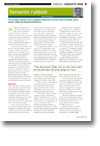
Taxing taxonomies
- Article 13 of 26
- M-iD, February 2005
A growing number of information managers are implementing taxonomies in a bid to improve customer retention and employee efficiency.
Page 1 | Page 2 | Page 3 | All 3 Pages
Both approaches also take into account document metadata, which can often prove more enlightening than the document content itself. Although this automated approach works best with flatter taxonomies that have few sub-levels, it is often surprisingly effective when combined with a suitable thesaurus that can match synonyms of words to their appropriate taxonomies.
But the thesaurus needs to be developed by the organisation to suit its own taxonomy, since it needs to take into account the organisation's culture and processes. For example, while “UK” could potentially be a synonym of “Europe” for the European Commission, it would not be for the anti-European UK Independence Party.
Keeping up-to-date
Even the best taxonomy will lose relevance and become ineffective if it is not kept up-to-date, so regular updating is a core part of taxonomy management. Systems that generate taxonomies and taxonomy maintenance tools can reduce the workload, although the former needs monitoring to ensure the taxonomy has not lost touch with business requirements.
Taxonomies intended to reflect businesses will need to be changed whenever changes to the business occur, such as mergers and new product releases. These changes will need human intervention, but by distributing responsibility for certain aspects of the taxonomies to relevant staff, the workload can be kept to a minimum.
While the workload involved may initially seem big, most organisations are more than capable of implementing and maintaining their own classification systems - and the savings, they say, can handsomely repay the effort.
Page 1 | Page 2 | Page 3 | All 3 Pages


